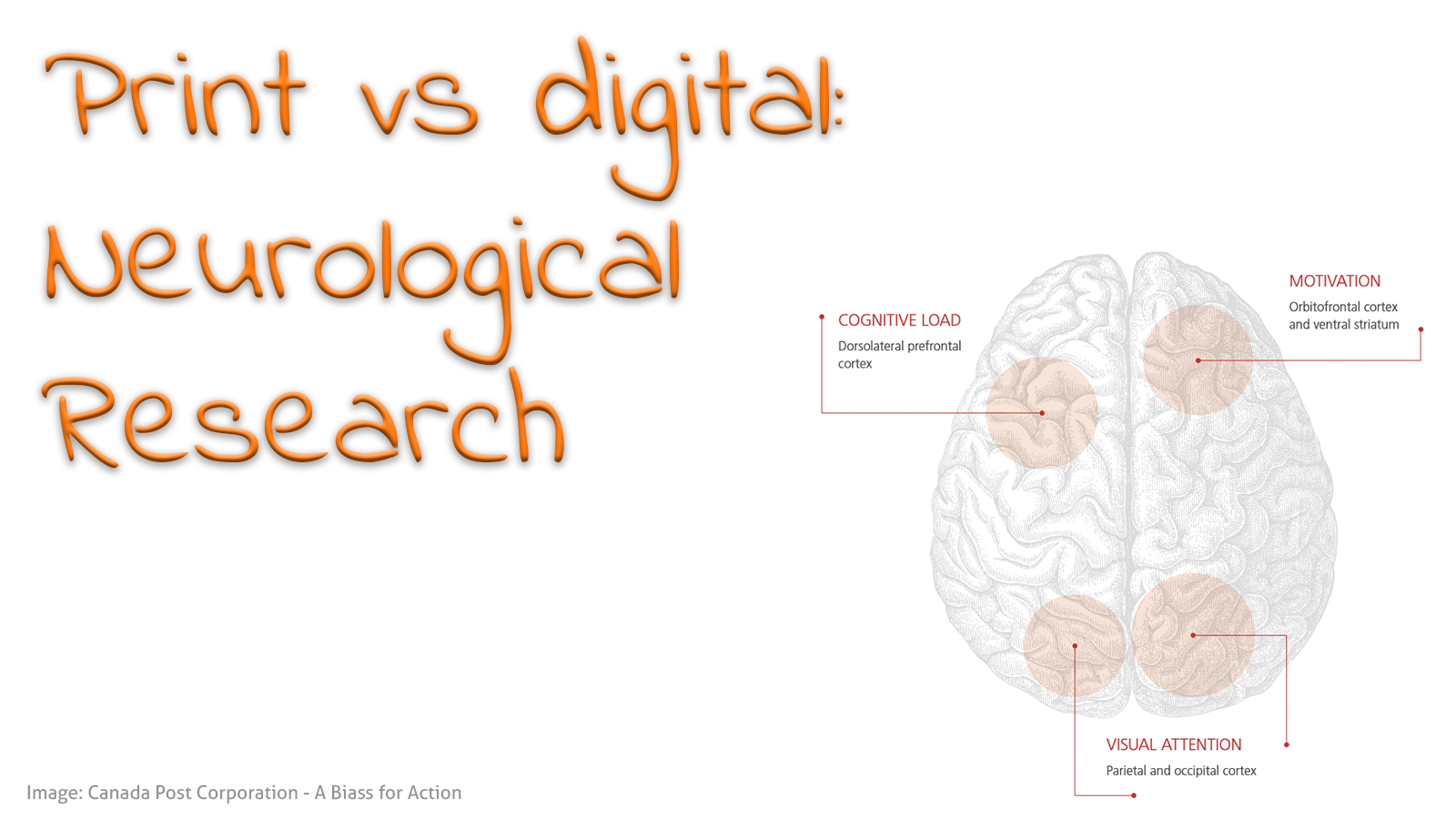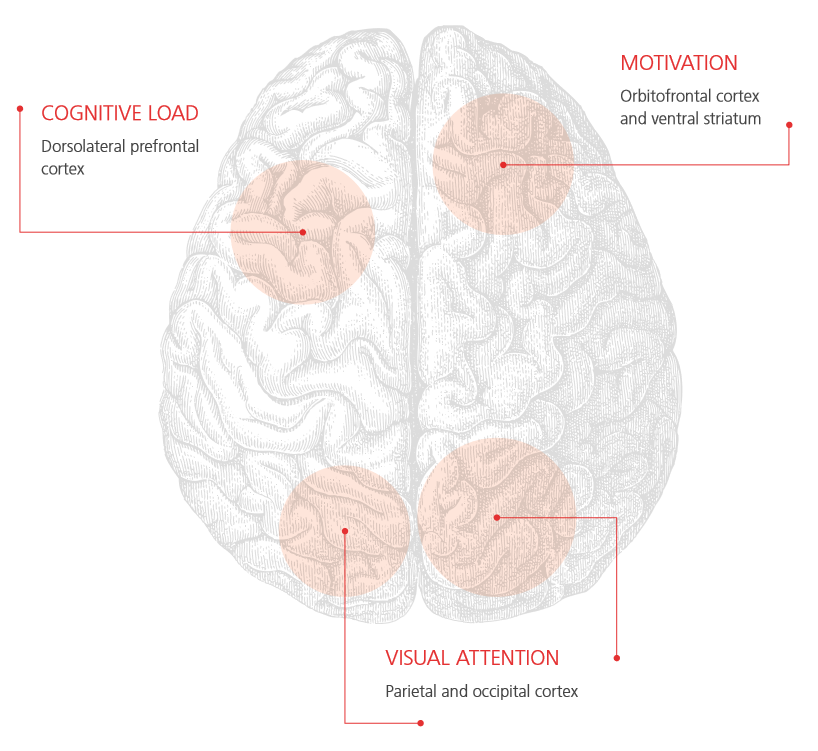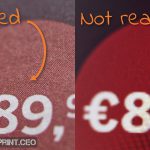
With the rise of digital information, digital communication, our way of reading, our way of consuming information has changed. And screens are not a 100% exact substitute for paper: our brain sees them differently. Let’s take a look at some scientific, neurological studies from the past few years on both the effect of digital versus print ads and reading texts on a screen or paper.
Canada Post (2015): A bias for action – The neuroscience behind the response-driving power of direct mail
This study used electroencephalography (EEG) and eye tracking to check the response of 270 participants. The study focused on ease of understanding and persuasiveness, plus the time needed to absorb the message.

The main conclusions from this study are:
- Direct mail is easier to understand and more memorable than digital media: it requires 21% less cognitive effort to process and elicits a much higher brand recall.
- Direct mail is far more persuasive than digital media: its motivation response is 20% higher – even more so if it appeals to more senses beyond touch.
- Direct mail is visually processed quicker than digital media: when considered in concert with its higher motivation and lower cognitive load, this suggests it gets the message across faster.
- Direct mail is more likely to drive behavior than digital media: surpassing the important motivation-to-cognitive load ratio threshold of 1.
USPS (2015): Enhancing the Value of Mail: The Human Response
Also from 2015 is research by the US Postal Services (USPS), in collaboration with Temple University’s Center for Neural Decision Making. They used eye tracking, core biometrics (heart rate, sweat, motion, respiration) and fMRI (functional magnetic resonance imaging for brain activity) to check the response to both digital and physical ads. In total 64 persons participated in the first phase, is the exposure to ads and the physical response (eye tracking, core biometrics). From that pool 48 people eventually participated in phase 2, is the fMRI, where the recall of ads and willingness to pay was checked.
The main conclusion: “The results of the study showed that participants processed digital ad content quicker. However, participants spent more time with physical ads. When viewing physical ads, participants had a stronger emotional response and remembered them better. Physical ads, though slower to get one’s attention at first exposure, leave a longer lasting impact for easy recall when making a purchase decision. Most importantly, physical ads triggered activity in the area of the brain (ventral striatum) that is responsible for value and desirability for featured products, which can signal a greater intent to purchase.”
Millward Brown (2009): Using Neuroscience to Understand the Role of Direct Mail
A bit older is the research performed by Millward Brown and Bangor University and commissioned by UK’s Royal Mail. They also used fMRI and tested 20 participants. The conclusion was that physical materials lead to a greater emotional processing, physical media is better at becoming part of the memory. The real experience is also internalized, which means the materials have a more personal effect, and therefore should aid motivation.
University of Stavanger (2011): Reading linear texts on paper versus computer screen: Effects on reading comprehension
The University of Stavanger in Norway performed a reading and comprehension test with 72 children, aged 15 to 16 year. Their conclusion is that reading narrative and expository texts on a computer screen lead to poorer reading comprehension than reading the same texts on paper. Which of course has a serious implication in education.
More studies, references
If you want to know more, I can recommend an article from Scientific American and a White Paper from MPA – The Association of Magazine Media (full report, 1-page summary). Both contain lots of references to studies that are relevant to this topic. And one important conclusion is the fact that we tend to scan digital information, while paper facilitates deep reading.
Other views
Yes, some reports have different findings, e.g. a 2016 master’s thesis “eBooks and Print Books Can Have Different Affects on Literacy Comprehension”. The study was limited to six kids (7 to 8 years old) and specifically used the enhanced e-book features, e.g. the included dictionary. The conclusion is that ebooks contain engaging reading features that help students improve reading comprehension. Since these kids were rather young and still learning how to read, could that be the reason why ebooks – and more specifically the enhanced features – showed better results?
Another study comparing the use of paper vs. tablets in education is from Coast Guard Leadership Development Center (2015). The number of participants in this reading comprehension test was 231, 119 of them read an 800-word article on a screen, 112 read the article on paper. A multiple choice test and a short-answer test afterward did not show a statistically significant difference in group means between paper and tablet readers. But: when looking into more detail paper readers had greater frequencies of higher scores for both multiple-choice recall and short answers that measured comprehension.
Why is this important?
The way our brain responds to information on paper or digital is different. Especially with advertising, this is different: we spend more time with paper, we recall paper ads better than digital ads.
But also when reading texts, there is a difference. When using digital information, we tend to scan it more, while paper facilitates deep reading.





Great post. The question is: How do we transfer the conclusions of these results to the customers or potential customers of printing companies?
Thanks Henk! How to transfer it: share it in every possible way! 🙂
Cut it any way you want, but eBooks are easier to revise, easier to transport, and less expensive than hard copy. We’re still in the infancy of using this media. Perhaps some effort in highlighting and reviewing is called for. Or perhaps we don’t remember much of what we read, no matter how we read it. How much do we remember from what we’ve read a month ago? A year ago? Do we come away from our reading with detailed knowledge, or just an impression of having liked or disliked something?
Thanks for your comment Pierre!
I agree that e-books are easier to transport and often less expensive (although not always). But I disagree on the rest.
The first generation of e-books readers and e-books was launched around the year 2000, that’s ages ago in technology. That’s long before the launch of smartphones. Would you say that – the ubiquitous – smartphones are still in their infancy?
I’ve published this article almost three years ago. Since then I’ve seen more studies confirming what I state in the article. Even some discouraging the use of electronic media in schools (especially with younger kids). Although they might be interesting for interactive applications, they are not for reading and learning how to read.
Thanks Eddy. In my opinion, the eBook has been out there without much emphasis on improving its functionality. There’s been a lot more emphasis on improving the smart phone because it’s a lot more important. My wife considers her smart phone an extension of her left arm, while my Paper White languishes by the bedside to be picked up for secret reading in the dead of night when I can’t sleep. The most obvious improvements I can think of for the eBook are the search engine and library management. Instead we get design mods to reduce the thickness of the eBook!? I would also argue that because of limitations imposed by screen size, eBooks are a poor choice for books with lots of pics and charts. That means text books are out, but novels and other text-heavy books are in. Could be that the eBook’s main forte will be reading for fun and not for study. I don’t think it comes down to either/or choices. It comes down to horses for courses: eBooks for pleasure reading, hard copy for taking tests.
Have a great day, Eddy. I love this early voting, BTW. I can sit back and watch the process unfold, knowing that I’m done and ready to move on.
Proprioception and feel is print books can’t be compared with digital print which has its own space. the good thing about digital media is it has broken the monopoly of print media